It is tough being a child. You have all these feelings bubbling up inside and you have no idea how to deal with them. Sometimes you don’t even have a name for what you feel. The adults in your life call you naughty and silly if you get too excited or scream and cry when things get overwhelming. So slowly you learn to bottle up those feelings. You learn how to “behave properly”.
But those feelings don’t go away. They stay inside for some time and one way or another they will surface in the form of another glass of wine, verbal or physical aggression, isolating ourselves, having harsh, critical thoughts about ourselves, feeling anxious and depressed and so on.
There has been a steady increase in the percentage of people who have some sort of psychological distress in the last few years. Considering this, one cannot help but wonder if more emphasis was put on Emotional Intelligence and self-awareness, would these concerning numbers drop. Many experts agree that the ability to regulate and control emotions, assessing own emotions and understanding their impact is vital for mental balance.
And this ability needs to be taught as early as possible through simple, yet effective emotional intelligence exercises both at school and at home.
But before we move on and look at some emotional intelligence activities for kids…
This post may contain affiliate links and I may earn a small commission when you click on the links at no additional cost to you. As an Amazon Affiliate, I earn from qualifying purchases. You can read my full disclosure here.
What is Emotional Intelligence?

Emotional intelligence (EQ- emotional quotient, or EI) is the ability to understand, manage and evaluate your emotions as well as other people’s. It is the ability to understand that emotions affect our behaviour and the way we interact with other people.
Emotional Intelligence is defined by self-awareness (recognizing your own emotions and how they affect you), self-management (being able to manage your own emotions in a healthy way), social awareness (understanding other people’s emotions, having empathy) and relationship management (being able to develop and maintain relationships).
Also read: How can the Multiple Intelligences Theory Help your Child?
Why is Emotional Intelligence Important?

Let’s think about our educational system for a minute. Which one has priority: EQ or IQ? The answer is, of course, IQ. The educational system prioritizes school subjects like Math, Languages, History, Geography etc but, in many schools, completely ignores EQ which is unfortunate.
Think what would happen if among the regular school subjects kids would also be taught empathy, how to deal with daily challenges and how to regulate their emotions. That scary percentage from above would probably decrease, we would have more balanced adults who are better equipped emotionally to deal with life’s curveballs.
Emotional intelligence in kids is incredibly important because:
- They are able to focus better
- They become more empathic
- Their engagement at school is higher
- They are able to deal with disappointment better
- They learn how to express their feelings instead of bottling them up
- They have more positive relationships with those around them
- They are able to communicate better
- Most of the time, they are able to resolve conflict in a way that works for everybody involved
- They are able to deal with stressful situations better
How can you improve your child’s emotional intelligence?
Even though some scientists say that we are born with a certain amount of EQ and that’s it, the majority agree that EQ can be taught and improved. This is great news. But how?
Well, the starting point, before we discuss any game or activity for developing emotional intelligence in kids, is OURSELVES. Kids “cannot be what they can’t see”. The adults in their life need to show them what empathy, kindness and compassion look and feel like. This means that, ideally, we have to do a bit of work with ourselves before we can effectively teach emotional intelligence to our kids. Letting go of our childhood baggage, learning how to (really) listen, being less judgemental and more understanding towards others are just a few steps. It is not easy and sometimes we may even need professional help but it’s so worth it.
Listening to our kids unload their big feelings without jumping to fix everything for them is another necessary step to improving emotional intelligence. Creating a safe environment where children know that they can talk and they can become vulnerable without any judgement is vital. Let them do the talking while you listen and just say things like “Oh, that must’ve been tough!”, “I understand”, “Wow, and then what happened?“, “How did you feel when that happened?”.
Another way of improving kids’ emotional intelligence is through games and activities. Here are 13 emotional intelligence activities for kids of all ages. Choose the activity that best suits your child’s age and personality.
Emotional Intelligence activities and games for kids
1. Name those emotions
In order for kids to be able to express their feelings, they need to have an emotional vocabulary. Teaching children the words for all those emotions that run through them is the first step in developing emotional intelligence in kids.
Take every opportunity to name those emotions as they present themselves (I know you are sad because you have to say goodbye to your friends), use flashcards with emotions and talk about feelings, both his/her feelings as well as other people’s, as often as possible.
Develop a wide array of emotional vocabulary for your child beyond sad, happy, scared, upset. The more words he’s got the better equipped he will be to express how he feels.
2. Role Play

One of the best emotional intelligence activities for kids is role-playing. It is an incredible tool not only for developing communication skills, confidence and creativity but also for teaching emotional intelligence.
Come up with situations that your child is likely to encounter in everyday life and act out together how s/he might behave. Discussions after the role-play are very important. How did s/he feel when this happened? Why did s/he react this way? Could s/he have reacted differently? How does s/he think the other people involved felt?
3. Journaling
This emotional intelligence activity is suited for older children who can write although younger children can use drawings. Recording themselves is also an excellent option.
Journaling is a safe place, free of judgement where kids/teens can write down all those bubbling feelings. It is especially useful for those who have trouble verbalizing their feelings. In this case, journaling offers a valuable outlet and a healthy way of processing feelings.
4. Breathing excercises
Deep breathing has a physical effect on our bodies that helps us calm down, reduce anxiety and stress. It is a shame that only adults do it. Why not teach children breathing exercises in a fun, playful way, of course. To make things interesting give each exercise a funny name and use props.
Here are some great ideas for breathing exercises for kids.
5. Kids Weekly Notepad
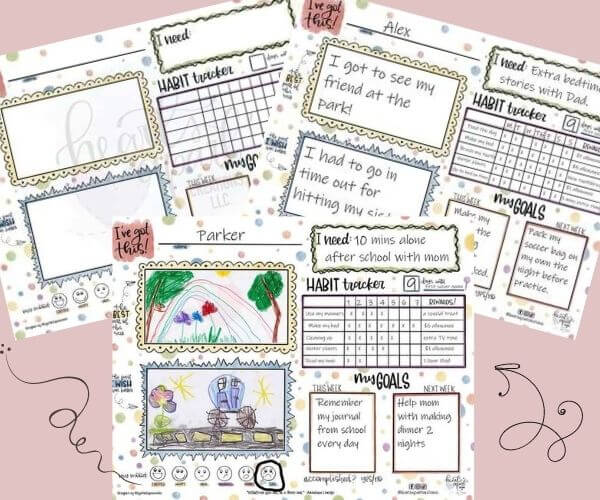
This weekly notepad is a great tool to encourage communication between the child and the caregivers. It has a beautiful design so kids will find it very appealing.
The notepad has eight sections:
- Name– All kids like to have ownership of their work so encourage them to write their names in this section
- I need– we all have needs and wants but sometimes it may be tricky to express them. This section opens up the opportunity to discuss what they need and why they need it. If the child has trouble expressing it, throw around some ideas like “Do you need more time in the morning to get ready?”, “Do you need extra storytime with Dad?”. When encouraged to express themselves constantly, you will notice that as time goes by, the kids will express their needs with confidence and ease.
- The best part of this week– This section encourages reflection of what they consider the highlight of the week. Younger children can draw a picture while older ones can write sentences.
- The part I wish was better– Not everything can go smoothly and kids need to learn that. This is another sention of the notebook that encourages reflection, this time of didn’t go that well. When discussing this part, in order to also nurture their emotional intelligence, be sure to ask them how they felt when that event happened.
- Habit Tracker– this is basically a little reward chart, where you can enforce good habits or deter unpleasant ones.
- ___ days until ___– this is a fun section that counts down to an event that your child is excited about.
- My goal this week/next week– setting goals establishes a sense of purpose and pushes kids to think of the necessary steps to achieve them. Older children can write their goals while younger ones can draw a picture. At the end of the week circle “yes” if the goal was accomplished or “no” if it hasn’t.
- My mood– this section encourages kids to explore their moods and talk about why they feel like that. There are six emoticons expressing different moods.
The Kids Weekly Notepad is a great way of teaching emotional intelligence to kids, celebrating the positive things, analyzing the unpleasant things and learning from that experience, enforcing good habits and all-around, encouraging communication.
This fantastic notepad contains 50 pages that cover an entire year. It has a unique, custom design that will enchant your little ones.
*Check out the Mood Buddies as well. They are beautiful, handmade wooden peg dolls that work perfectly with the Kids Notepad. Mood Buddies are great for play therapy.
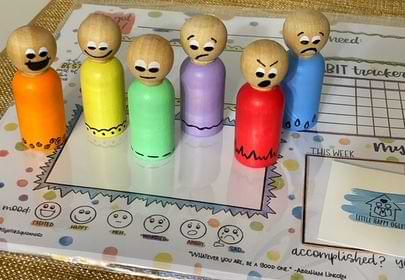
If you want to get the Kids Weekly Notepad and other awesome products, visit Hearts Apart creations shop or check out Facebook and Instagram.
6. Shake the feeling
Emotions are motion. When we have different emotions they make our bodies feel and move in a certain way. Movement can be a great release for emotions.
So, a fun emotional intelligence game is to give each feeling a type of movement. For example, for happiness, they could skip, for anger they could stomp, when they feel anxious they could shake their bodies and so on.
7. The feelings jar
The feelings jar is a great self-regulatory activity to help children recognize and deal with their emotions.
Have the child write down or draw what they are feeling and put it in the jar. This especially works for negative feelings as you can tell the child that the unpleasant feeling goes from their bodies to the paper and then gets locked away in the jar.
If you want to add a sensory component to the activity, assign each feeling with an object. For example, angry can be a small, spiky ball, happy can be a soft pom pom, surprised, a small, squishy toy etc. Have the child take the appropriate object and put it in the feelings jar.
8. Balloon pop
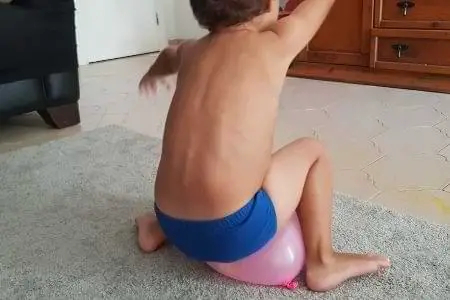
Another great sensory activity that helps children regulate their emotions, not to mention the fun, is feelings balloon pop.
Simply write or draw the feeling in the balloon and then pop it. If you don’t want to use a sharp object to pop the balloon, have the child step or sit on it until it pops.
9. Play emotions Charades or Pictionary
Charades and Pictionary are great games to teach emotions to kids.
Charades is the game that we all know and love where one person mimes something, in our case an emotion, and the other player(s) try to guess what it is. Pictionary is the same, except instead of miming, you draw.
10. Show emotions in the mirror
A simple, yet effective activity to develop emotional intelligence, especially for young children, is to “make a face” for each emotion while looking in the mirror.
Babies and toddlers love looking in the mirror so take this opportunity to teach them the names of feelings.
11. Read books about emotional intelligence
We resort to books whenever we want to explain or teach something to our kids. They are invaluable tools that use appropriate language, appealing images and interesting stories to explain different concepts.
There are many books out there that teach children how to manage their strong emotions. A few that I recommend are
- “The Rabbit Listened” (absolutely charming this one)
- ” The Color Monster” (a great 3D pop-up book)
12. Mindfulness Exercises
Mindfulness exercises are a great activity to improve emotional intelligence, focus, reduce stress (yes, unfortunately, kids get stressed as well) and help people be aware of what’s happening outside of themselves. Like a muscle, mindfulness takes practise to build up.
If you need inspiration, here are 10 mindfulness exercises for kids that you can try at home.
13. Emotional Intelligence games
One of the best ways to teach emotional intelligence to kids is by playing. There are many board games out there that besides being fun, they address the topic of emotions and how to manage those strong feelings.
Here are a few favourites:
- Don’t Go Bananas– a card game in which players answer question prompts about different emotions and situations as they play the cards
- My Feelings– a great board game that encourages children to recognize, explore and act out their emotions.
- Happy or Not– a game that helps children recognize a wide array of emotions and use them in realistic, day-to-day scenes.
- Feelings and Emotions Flashcards– the pack contains 48 large cards that can be used to teach emotions and play different games like matching, memory game and more (the pack contains five educational game ideas).
- Miniland Emotiblocks– an amazing game for younger kids that comes with big, easy to handle manipulatives. The pack includes 18 pieces/blocks that can be mixed and matched according to the Activity Cards. There are over 100 possible combinations.
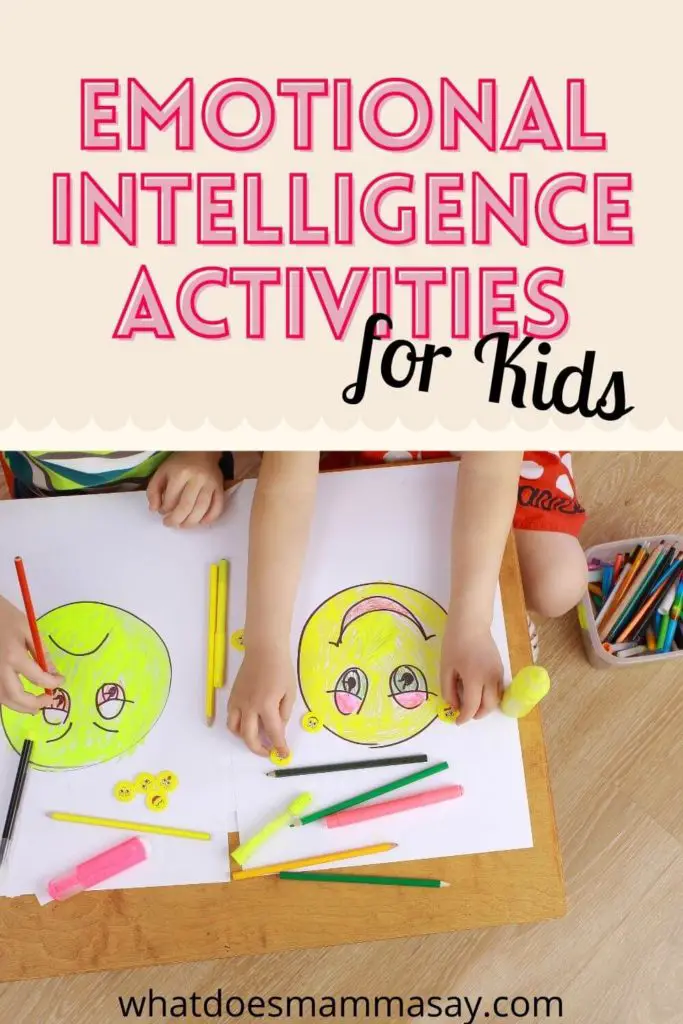
In his book, “Emotional Intelligence, why it can matter more than IQ“, author and psychologist Daniel Goleman states that IQ makes up only about 20% of the factors that determine success in life. Only 20%!
And yet the educational system puts (in most schools) 100% emphasis on IQ, ignoring EQ.
Until this changes, it is our responsibility, as parents, to teach emotional intelligence to our children and help them become happy, balanced adults.
There isn’t a set age to start doing this, the sooner, the better.
If you found these emotional intelligence activities for kids helpful, be sure to share them with others!

Mom of two wonderful children, dedicated teacher and book lover.

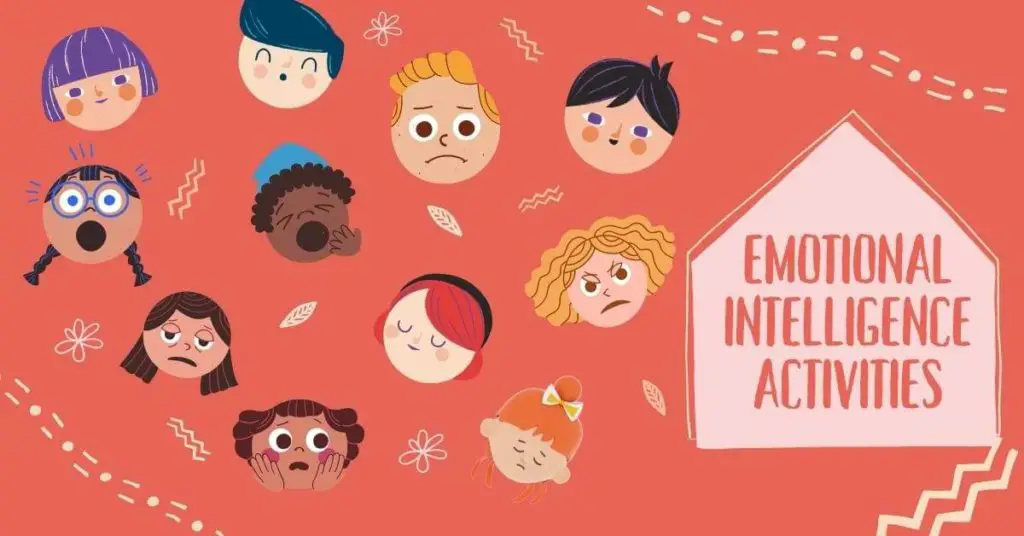


This is such a great read; I love all of the activity ideas! I also agree that listening to our kids without judgement is crucial. Thanks for sharing!
Thanks for sharing these resources.